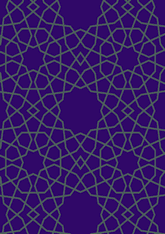Gur-e Amir, Mausoleum, Samarkand
 data167/P118B
(Click on image for high-quality PDF version)
data167/P118B
(Click on image for high-quality PDF version)
See also Friday Mosque, Varzaneh.
Geometry
- The symmetry group of the tiling is *442 (p4m).
- All the internal angles of the constituent polygons are a multiple of 7.5°.
- Contains one regular two-pointed star polygon with vertex angle of 75°.
- Contains one regular 8-pointed star polygon with vertex angle of 90°.
- Contains one regular 12-pointed star polygon with vertex angle of 105°.
- There are 7 non-regular reflective tiles (including one kite).
- The tiling satisfies the interlace condition and has three finite interlaces and no infinite interlace with straight cross-overs.
- The tiling is edge-to-edge.
- As drawn, contains about 385 polygons.
References
Publications referenced:
- Page 447, Fig. 384a (Friday Mosque, Shiraz, Iran) from [bonner] (1351AD, 751AH)
- Christie's sale item, 7389/17 (Central Asia. Four Timurid Cuerda Seca Tiles) from [pc] (15th century AD)
- Photo by David Wade: TRA 0122 (Gur-e Amir Mausoleum, Samarkand, Central Asia) from [wadei] (1404AD, 806AH)
- Figure 245 (Friday mosque, Yazd, Iran) from [pope]
- Page 118, bottom (Gur-e Amir Mausoleum, Samarkand, Central Asia. Pentagons not regular) from [degeorge2]
- Photo by Brian McMorrow (Tomb of Amir Temur (Tamerlane), Samarkand, Central Asia) from [pc]
Photographs
Collections of similar tilings
Patterns using same irregular tiles: 2
v54

